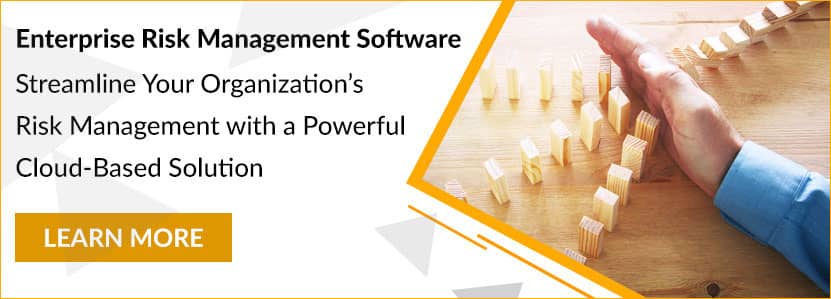Home/ Blog / How Real-Time Risk Analytics Help Financial Organizations
Real time risk analytics is one of the most revolutionary parts of modern risk management frameworks. It is important to remember that previous to data analytics tools, it was almost impossible for most banks to access analytics in real-time. Banks and financial institutions collected risk data in spreadsheets and documents. Analysis of risk data was only possible after it had been cleaned up and standardized to be used for analytics. The steps involved meant that almost all the graphs and reports management had were based on old data.

Real-time risk analytics uses data streams to provide a current view of the risk exposure of the organization. Risk managers can easily drill-down and look at the current metrics, trends, and progression on risk related tasks and activities. This benefits financial organization in multiple ways, such as:
Improved Understanding of Risks
With analytics, financial institutions may begin to dismantle the silos that separate their data repositories. By facilitating seamless data flow throughout the company, stakeholders can aggregate data, control its integrity, and gain access to critical information. Increased confidence in loss predictions for ongoing efforts, facilitated by improved data quality and smart application of predictive analytics, may provide insight into areas where conservative capital buffers might be reduced. This frees up funds for growth activities.
Additionally, effective analytical techniques enhance the precision of performance comparisons between regions, lines of business, and other company segments. With knowledge driving choices at all levels of the organization, from the CEO to each line of business, financial institutions can allocate capital to optimize their risk-reward profile. Additionally, they can restrict investment in initiatives that generate short-term profits at the expense of longer-term stability and reward those that generate actual long-term value, optimizing their returns on capital for the level of risk faced.
Business Intelligence for Decisions
Predictive analytics can be used with external and internal risk data to forecast changes in a region’s or industry’s risk rating and creditworthiness. Through this approach, the losses in anticipated challenging business lines can be reduced in advance, preventing over-investment. Additionally, reliance on more predictive models can help expedite decision-making and respond more swiftly, enhancing the ability to fine-tune business strategy dynamically.
When risks are being managed manually, concerns with data quality and availability necessitate significant manual involvement. Increased data quality would decrease reliance on manual processes, lowering both operational costs and mistake rates. Additionally, with more immediate data on client product and service choices, financial institutions would be better equipped to improve their market offerings continuously.
Real time risk analytics uses data streams to provide a current view of the risk exposure of the organization. Risk managers can easily drill-down and look at the current metrics, trends, and progression on risk-related tasks and activities. Share on XManagers like to have as much business intelligence as possible when they make a decision. This means that they must ask for the latest data and reports whenever there is a decision to be made. Real-time risk analytics provide managers with real-time reporting whenever needed. This can result in a paradigm shift in the way decisions are made across the organization. Instead of relying on intuition and outdated data, managers can make decisions based on analytics and predictions from real-time data streams.
Identifying Growth Opportunities With
Real Time Risk Analytics
A more holistic understanding of financial institutions’ liquidity and capital positions, both under stress and under expected conditions, enables more targeted growth options that complement the financial institution’s current risk profile and helps the organization mitigate risks. For instance, risk diversification benefits may lead to synergies between a new product and a market, which may be analyzed and valued more correctly with the right data and analytics.
Conclusion
Banks are moving towards the development of an integrated data model that combines enterprise risk data with other internal and external data sources to create a base knowledge framework from which further analytical processes can flow.
At the peak, where the analytics journey culminates, sits the insight-driven organization, reaping the benefit of enhanced foresight. To scale this peak, however, financial institutions will need to move beyond descriptive data analysis based on historical performance to increasingly predictive and even prescriptive forms of analysis.
Fortunately, the application of analytics—and the recognition of its relative importance to performance and success—is growing. Companies have slowly started investing in analytical capabilities and integrating analytics into decisions and processes, and even basic investments in risk analytics can move companies up the maturity slope. However, those organizations that fully embrace analytics across the enterprise stand to gain even more than the ability to tackle the most complex business problems and address evolving global economic trends in near-real-time. With the right strategy, people, processes, data, and technology in place, these forward-thinking financial institutions will be positioned to take a true leadership position in today’s evolving data-driven business world.
Interested in seeing how real-time risk analytics can help your organization? Get in touch with our risk management experts for a demonstration of what our American Bankers Association endorsed risk management solution can do for your organization.
Request a Demo
Complete the form below and our business team will be in touch to schedule a product demo.
By clicking ‘SUBMIT’ you agree to our Privacy Policy.




